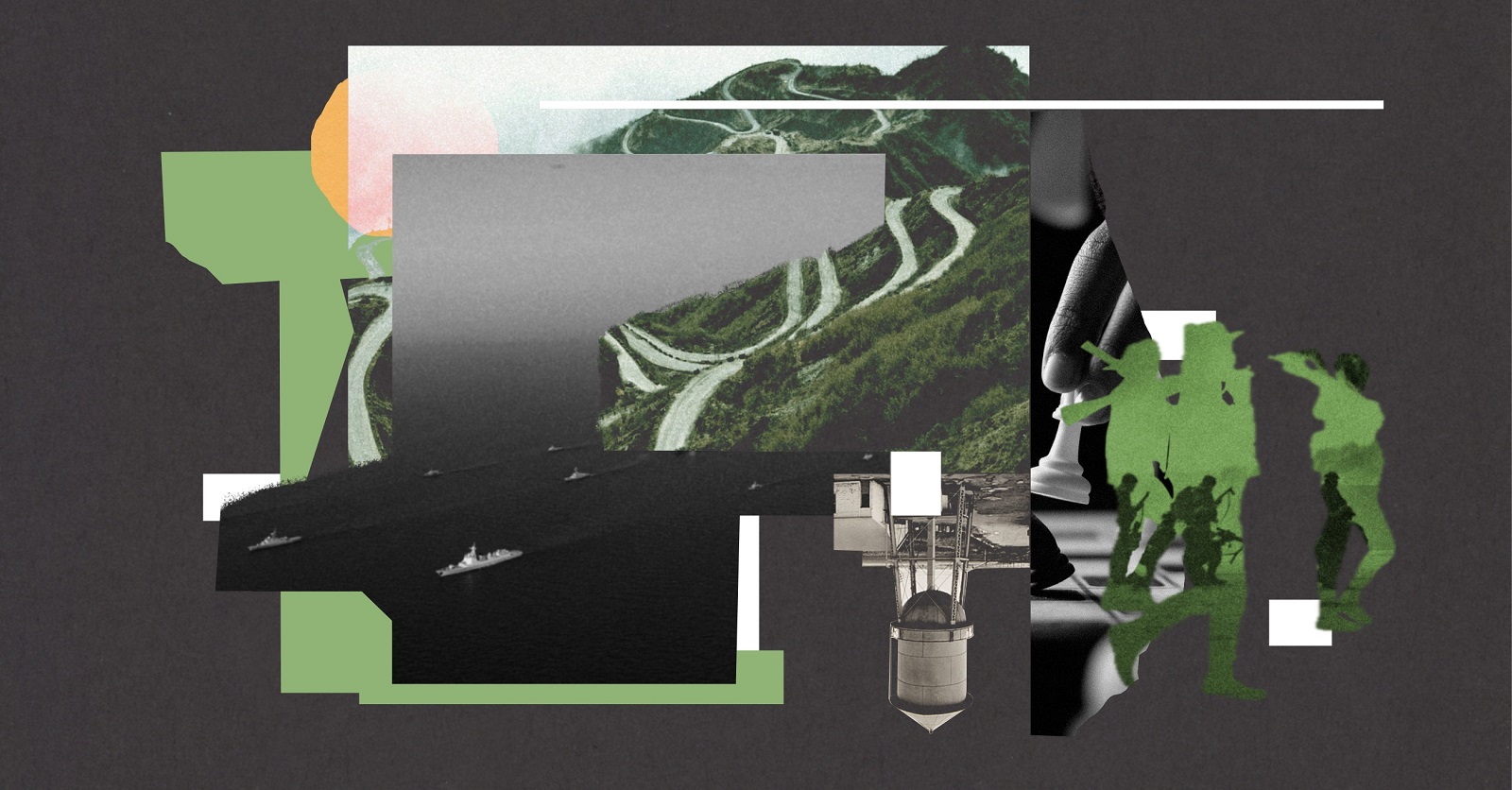

2024 has gotten off to a bad start, with several destabilizing fires fueling the specter of a widespread conflict, and an arc of crisis stretching from the Mediterranean to the Caucasus. The prospect of a Russian victory in Ukraine, or at least a negotiated outcome unfavorable to the West, should prompt reflection on the disparity between reality and the narratives presented in many media organizations.
Western disengagement in Syria, the shift of the war in Ukraine, the recent events in Gaza, and the shockwave caused by ethnic cleansing in Artsakh are not isolated events, despite each following its own logic. They are the logical consequence of a security vacuum that coincides with the disengagement of the West in general, and the United States in particular, from these primary hotbeds of regional tension.
While this security vacuum increases instability, it also benefits regional powers, which until now had been relegated to a secondary role. In this context, each actor plays its own part. Without a conflict-regulation mechanism, or a Leviathan, the Hobbesian logic reemerges. Military alliances, increasingly costly or ineffective as seen with the CSTO, give way to partnerships. These partnerships are inherently more flexible, opportunistic, and operate within a bilateral framework with shifting boundaries.
The rise of Turkey is a case in point. This middle power is leveraging the relative decline of the West to maximize its advantage. Its diplomatic ability in flipping an initially unfavorable balance of power, positioning itself as an opportunistic power that is both a member of NATO and a partner of the Russian Federation on many issues, speaks volumes.
In hindsight, the 44-day war of 2020 was merely a successful attempt by Turkey to establish a foothold in the South Caucasus, previously dominated by Moscow, and try to replicate the Syrian scenario. In other words, competitive cooperation with Russia is based on defining zones of influence.
Therefore, it is important to always opt for a global view of the regional situation, rather than focusing solely on the Armenian-Azerbaijani, Armenian-Russian, Armenian-Iranian, or Armenian-Turkish dynamics.
Since 2020, Armenia has clearly become a prime victim of the geopolitics of empires, and the collateral damage of the Russian-Turkish rapprochement was meant to undermine and keep the West out of the region.
Armenian observers, largely focused on internal dynamics, have often overlooked the rapid geopolitical changes of this decade.
Azerbaijan’s transformation into a medium-sized power with all the attributes of sovereignty is also a textbook case. This Turkish-speaking country, which is not necessarily aligned with Ankara’s policies, uses pan-Turkism as an opportunistic tool, and has successfully duplicated India’s multi-alignment diplomacy. Evidence of this can be seen in its involvement with NATO (as demonstrated by Azerbaijan’s involvement in Afghanistan) and Russia, as demonstrated by the strategic partnership established before the offensive against Ukraine.
These accelerating geopolitical shifts signal that we are already in a new type of global conflict, A Third World War whose moniker is yet to be decided. The main point of contention in this war is the control over energy and strategic transportation routes. In this respect, Armenia’s 44-kilometer-long Syunik region is more than just a geostrategic barrier preventing a connection between Turkey and Azerbaijan via Nakhichevan. It’s a conduit for new Silk Roads, a role played by the Araks plain since the Middle Ages. Ukraine continues to serve as the breadbasket of Eastern Europe, acting as a strategic reserve for consumer countries, most of which are in Africa.
Artsakh and Syunik are cradles and shields of the Armenian nation due to their terrain, historical significance, and place in the national consciousness. More than symbols, these strategic regions are rich in water and mineral resources. The war that led to the annexation of Artsakh was not just about territory but also control over these resources. The British, already present in the region in 1918, recognized this. Their pro-Azerbaijan policy was a part of the Great Game against hegemonic Russia and its vassal Armenia, a policy that seems to persist beyond Autumn 2020.
The Arab and Muslim East is also a world of political geography. This importance stems from its critical position on the trade map and the numerous wars it has experienced, which have influenced social and ideological transformations, modes of production, commercial and military alliances. Moreover, the region has seen the development of political projects developed in the 20th century, such as the pan-Arab project for the unification of the Fertile Crescent and the Greater Syria project. More recent projects include the War on Ports and Historical Routes, such as the New Silk Roads initiated by China (BRI), and the India-Middle East-Europe (IMEC) economic corridor project, which will connect India to Europe via Israel, near the Gaza Strip.
There is a noteworthy, pharaonic and extremely costly Israeli project worth several tens of billions of dollars. It aims to create the Ben Gurion Canal, which would link the Gulf of Aqaba to the Mediterranean Sea. Despite being nearly half the length, it would rival the Suez Canal. More realistically, there’s a project to transform the port of Haifa into the main port of the Middle East. Lastly, the Saudi project intends to create a megalopolis called Neom built up from the sand. This city of the future, a folly dreamt up by Prince Mohammed bin Salman three months after coming to power, will be located in the north-west of the kingdom, close to Jordan, Israel and Egypt. This in part explains the renewed activism of the Iranian-backed Yemeni Houthis to disrupt traffic in the Red Sea. Iran, a member of BRICS, has succeeded in pushing its agenda on several issues, while minimizing its exposure.
The Syunik Corridor, the Red Sea, Ukraine, and the Black Sea are the epicenters of new and upcoming conflicts. For Armenia to survive in this hostile and threatening environment, relying solely on military aid from France, Iran and India will not suffice. It’s up to its leaders to revolutionize their worldview and strategic approach.
From this perspective, new technologies will be decisive, but may not hold much significance if demographics don’t keep pace. Armenia’s birth rate is alarmingly low, and the potential mass exodus of refugees from Artsakh is a significant concern. There remains the demographic reservoir of the diaspora and its potential.
Until the authorities of the Republic of Armenia address this critical factor in repopulating a country threatened with extinction, the hollow slogans of the 1990s (Georgia has the sea, Azerbaijan the oil, Armenia the diaspora) will remain just another pipe dream.
Opinion
“Western Azerbaijan”, Pan-Turkism and International Law
This article presents a comprehensive perspective on the concept of “Western Azerbaijan,” portraying it as a continually evolving agenda that Azerbaijan might be integrating into a broader framework of bolstering Turkish influence in the Caucasus.
Read morePolitics
EU, U.S. Elections Could Test Armenia’s Resilience
As the geopolitical landscape in the South Caucasus remains precarious, potential changes in EU and U.S. leadership can pose additional challenges for Armenia. Amid these uncertainties, Armenia's diplomatic efforts become increasingly important and serve as a test of its resilience.
Read moreHypocrisy and Mystification: Azerbaijan in the Non-Aligned Movement
The Non-Aligned Movement is a diplomatic platform where Azerbaijan, as a major oil-producing nation, tries to exert influence by supporting ex-colonies that are purportedly fighting colonialism. Garren Jansezian explains.
Read more




A short and incisive summary of the challenges facing Armenia’s security. Armenia’s and Artsakh’s leaders were inflexible and did not respond to the changing dynamics between Turkey and Russia, resulting in the total loss of Artsakh. Hopefully Armenia will be more agile in the future and respond to the changing geopolitics as described in the article. One aspect of the Caucasus which has always puzzled me is why Armenia and Georgia do not form a strategic alliance to deal with these difficult issues. It’s in the interests of both small countries to combine their defense and economies to have more agency in a dangerous region hemmed in by Russia, Turkey and Iran.